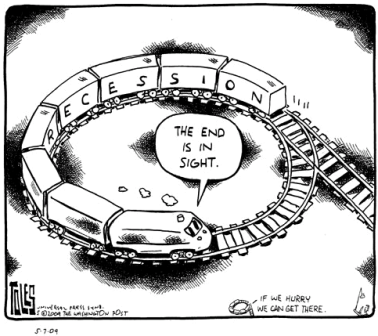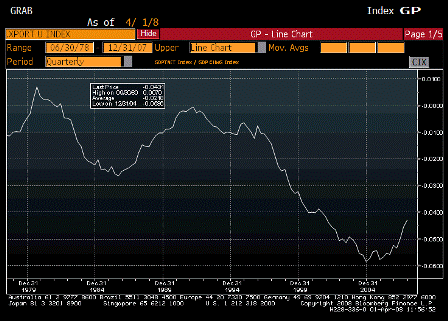[Skip to the end]
(email exchange)
All a bunch of true but not relevant crapola.
All 6 US depressions were preceded by the first 6 periods of budget surpluses.
The 7th ended in 2001, as Bloomberg announced it was the longest surplus since 1927-1930.
The difference now we are not on the gold standard so the Treasury can deficit spend at will to restore and sustain aggregate demand.
Yes, it is that simple.
A payroll tax holiday and a few hundred billion of revenue sharing and within a few weeks everyone will wonder what all the fuss was about.
And if nothing fiscally is done, it will be like the early 90’s where the deficit went up via falling tax revenues and rising transfer payments until it gets large enough to restore output and employment.
But that can take a few years.
And nothing is gained by not doing a proactive fiscal adjustment.
(And don’t forget the energy policy to keep gasoline and crude oil consumption down!)
Happy Holidays!
Warren
>
> On Mon, Dec 22, 2008 at 7:24 PM, Morris wrote:
>
By Martin Hutchinson
Remember the Great Depression of 1921? Or of 1947? Or of 1981? Each of those years began with many of the same problems evident today, or that were evident in 1929-30. Yet they did not produce more than garden-variety recessions, which were soon over. It is instructive to examine why.
The preconditions for depression in 1921, 1947 and 1981 were similar to those operating today, and rather more severe than those of 1929-30. In each case, a large percentage of U.S. assets, built up over the preceding few years, had become obsolete and needed to be scrapped. In 1921 and 1947 the excesses consisted of surplus capacity built to provide munitions for World Wars I and II, together with the boom-time optimism additions of 1919 and 1946. In 1981, the excess consisted of a combination of U.S. factories that had become hopelessly internationally uncompetitive (think Youngstown, Ohio) and capacity that was impossible to retrofit to meet new tighter environmental standards, imposed with such enthusiasm in the 1970s.
All three of these downturns involved an “overhang” of assets that were no longer worth their cost, and associated debt that would default, similar to the housing overhang of 2008. Only in 1929-30 was the overhang less obvious initially, but an overhang was produced during the downturn by the insane political imposition of the Smoot-Hawley tariff, decimating world trade.
The 1921, 1947 and 1981 recessions were short and fairly mild, and 1929-32 became the Great Depression because of government action responding to the initial downturn. In 1929-32, as is well known, government produced the Smoot-Hawley tariff and the huge tax increase of 1932; and the Federal Reserve failed to prevent money supply collapsing after the Bank of the United States crashed in 1930, sparking widespread runs on banks across the country. As a minor addendum, President Herbert Hoover and his acolytes also followed a policy of keeping wage rates high, which was continued by President Franklin Roosevelt and the Democrats after 1933 – thus condemning 20% of the workforce to a decade of unemployment while unionized labor fattened its working conditions.
The mistaken policies of 1929-33 were generally not followed in other downturns. In 1921, Treasury Secretary Andrew Mellon, who believed in allowing the private sector to liquidate its way out of recession, was at the peak of his powers; he therefore organized no bailouts, but instead cut public spending to reduce government’s burden on the economy (he was still there in 1929, but was consistently overruled by Hoover.) In 1947, the Republican 80th Congress also cut public spending sharply and passed the Taft-Hartley Act restricting union power. The backlog of growth potential from technological advances made during the Great Depression and World War II might have lessened the destructive force of 1947’s downturn anyway, but Congress certainly helped rather than hurt. In 1981, incoming President Ronald Reagan restricted government’s spending growth, cut top marginal tax rates and allowed the Paul Volcker Fed to squeeze inflation out of the system – all actions that brought recovery closer.
In none of the 1921, 1947 or 1981 recessions did government engage in massive bailouts (the Chrysler bailout – only $1.5 billion, less than 0.1% of Gross Domestic Product – was passed in 1979, before the main leg of recession hit). Neither did the government indulge in stimulus packages in 1921, 1947 or 1981 (although President Reagan’s tax cuts had some stimulative effect in 1982-83); instead its stand on public spending on all three occasions was markedly restrictive. Finally, at no time in 1921, 1941 or 1981 did the Fed run a negative real interest rate policy; instead real interest rates were positive in all three years, sharply so in 1921 and 1981.
Internationally, the potential to become Great Depressions: 2001 was marginal as the asset overhang, from stock and telecom sectors, and was bailed out by the Fed (at the cost, we now know, of a worse recession 7 years later.); 1991 had only a modest overhang of bad housing finance assets – the rest of the economy was in great shape after the ebullient 1980s; 1974 had a substantial overhang, but the novelty of both high oil prices and environmental restrictions made the overhang less obvious than in 1981, and President Gerald Ford’s restrictive public spending policy, together with a 2001-like monetary bailout through high inflation and lower interest rates prevented it from metastasizing; 1970, 1958 and 1937 had no great new asset overhangs to deal with, although in 1937 the economy was still unbalanced from 1929-32. Thus only about a third of recessions have the potential to turn really nasty, and it appears that government actions, in one direction or the other, determine whether they do so.
Internationally, the Japanese recession after 1990 involved a huge asset overhang, from stock and real estate investments made during the 1980s bubble. The Japanese authorities got policy partly right. They did not sharply increase taxes as did Hoover in 1932, nor did they become significantly more protectionist – indeed they liberalized somewhat. On the other hand, they indulged in an orgy of unproductive infrastructure spending, driving their public debt ratio to over 180% of GDP and “crowding out” private sector borrowing, which was restricted anyway by banks’ lack of capital. After 1998, they drove real interest rates below zero, reducing the domestic savings rate and delaying true recovery.
That recovery only occurred when Prime Minister Junichiro Koizumi cut wasteful infrastructure spending and moved towards a balanced budget, thus freeing up finance for the private sector. However, new Prime Minister Taro Aso’s insistence on wasting yet more money on public spending and the Bank of Japan’s failure in 2006-08 to raise interest rates to a positive real level may well produce in Japan a recurrence of downturn like that of 1937 in the United States, an entirely unnecessary aftereffect of poor public policy.
In the United States in 2008, the current unpleasantness clearly has the potential to become much worse. The asset overhang from the housing bubble is comparable to those of 1921 and 1981 (relative to the U.S. economy) and probably larger than that of 1947, when the memory of Great Depression prevented much postwar “irrational exuberance.” Moreover, public policies of bailout, spending stimulus and negative real interest rates all tend towards producing a “Great Depression” although some of the worst mistakes (protectionism, savage tax rises) of 1929-32 have so far been avoided.
This time around, bailouts have been used on a scale greater than Hoover’s Reconstruction Finance Corporation. The Troubled Asset Relief Program (TARP) gave a spendthrift lame-duck administration and a personally conflicted Treasury secretary complete license to throw money at any problem that appears politically threatening – thus the current attempt to use bank bailout money to assist auto manufacturers, even after Congress has failed to pass an aid package. An initial recapitalization of the banking system, costing about $200 billion, may have been necessary, but the TARP proposal to spend $700 billion on dodgy mortgage assets was an appalling waste of money and in the event unworkable.
In any case, the initial injection of capital to banks should have been definitive. When Citigroup came back for more, only weeks after having been given $25 billion of new capital, it should have been forced into bankruptcy, possibly through an orderly liquidation under government-appointed administrators to minimize market disturbance and unanticipated losses. The financial services industry needs to downsize, which involves removing the worst-run competitors, an accolade for which Citigroup certainly qualifies. Conversely the automobile industry should be able to survive, but only after Chapter 11 filings have removed old union contracts and pension obligations, and allowed the U.S.-owned auto companies to streamline their model ranges and reduce wage costs to their competitors’.
By prolonging the life of incompetent banks and overstuffed union contracts, the government is making matters worse and increasing the probability of serious trouble. It is essential that TARP be closed down and that the window for government bailouts, in banking and elsewhere, is slammed firmly shut. By preventing the market’s destruction process from operating, the government makes the recession almost certainly deeper and without doubt horribly artificially prolonged.
Stimulus plans also raise the chance of a Great Depression because of the deficits they cause. When the government sucks more than $400 billion out of the U.S. economy in two months, it should not be surprised when the credit crunch worsens for the private sector. Indeed, the earlier tax rebate stimulus of the summer may well have caused the surge in unemployment, of over 400,000 per month, which occurred from September onwards. The crunch point for finance availability in a crisis occurs not in the large companies (except those that are due to fail anyway) but in medium-sized and smaller companies, the principal creators of jobs, who find credit lines pulled and survival impossible. The money for stimulus packages has to come from somewhere; when the public sector deficit is already bloated, it comes straight from the job prospects of small company employees and the self-employed.
Loose monetary policy can work either way. When an asset overhang is limited, it can make finance cheaper, raising equilibrium asset prices and limiting the force of a downturn. It was successful in doing this in 1974 and 2001, at the cost of worsening inflation in the 1970s and a more virulent asset bubble in the 2000s. However, when the asset overhang is large enough and the collapse in banking confidence sufficiently severe, loose money can no longer bail the system out of a downturn. Instead it becomes a further depressing factor, eliminating the returns for saving, preventing capital formation and keeping stock and asset prices above the depressed level at which further investment is truly economically attractive. That’s what happened after the Smoot-Hawley tariff disrupted economic activity in 1930, and it is what appears to be happening after the banking crisis of September-October. Whether or not negative real interest rates produce inflation, they will certainly in such circumstances delay recovery.
Current policies could potentially turn today’s recession into tomorrow’s Great Depression. Let us hope that President-elect Barack Obama’s team of economic wizards can figure out a way of preventing this.
[top]



